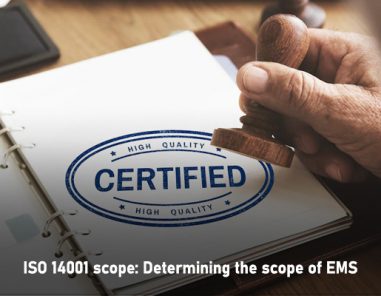
ISO 14001 scope: Determining the scope of EMS
Determining the scope of your Environmental Management System (EMS) is vital ...
Read MoreEvery organisation wants an efficient management framework that cuts out the unnecessary hassle and the requirement for multiple management systems. They all yearn to have a management system, that withstands the strain of multiple audits and continues to reap their benefits year after year. An integrated management system provides all of this and much more. In the following article, we will take a deep dive into this topic.
An Integrated Management System (IMS) blends all elements of an organisation’s processes, systems and standards into one cohesive entity. This amalgamation allows businesses to streamline their management, save time, increase efficiency as all elements of the operations are addressed in one comprehensive management system.
An efficient IMS removes needless hassle and bureaucratic procedures as all management systems are systematically combined.
A great example of how an IMS preserves time is that instead of holding audits for each standard of the management system, you can audit the management system to measure the efficiency of every process. This is because an IMS combines processes in such a manner that they simultaneously cover all standard-specific requirements.
Traditionally, organisations used to focus on different management systems, individually, or in silos, oftentimes leading to conflict. For example, the quality team would focus its attention on maintaining the Quality Management System (QMS), whereas an EMS manager would handle all queries related to the Environmental Management System (EMS). However, since all processes are integrated into one complete framework, it enables the organisation to work as a single unit with unified objectives. Using ISO consulting services, you can start your integrated management system right now.

There are multiple benefits of an IMS, including:
Before we jump into integrated management systems, let us discuss the common types of management systems that are prominent in the business world today.

The quality management system is a set of procedures, processes, and policies that are needed for planning and executing core business areas of an organisation, impacting the organisation’s ability to meet customer requirements. ISO 9001:2015 is a great example of an QMS. ISO 9001 is a widely used standard that is used as the most popular ISO certification for manufacturing.
An Environmental Management System (EMS) identifies and continually improves a company’s environmental position and performance. ISO 14001 certification is a great example of an efficient and sustainable EMS. Occupational Health and Safety Management System (OHSMS) determines and continually improves a business’s position on occupational health and safety.
ISO 45001 is the world’s most popular standard for occupational health and safety (OH&S), which sets the requirements for an OH&S management system. It is the first international OH&S standard, combining years of industry OH&S best practices from all over the world into one single clear framework. It is particularly concerned with analysing an organisation’s potential risks and benefits in its day-to-day operations, using a process-based approach. Its aim is the prevention of workplace accidents through workflow improvement and the integration of OH&S into the fabric of organisations.
ISO 27001 is the international reference for information security standards. It sets out the requirements for the Information Security Management System (ISMS), used by organisations of all shapes and sizes across all industries, for managing the confidentiality, integrity, and availability of information assets, including client, organisation and employee information. ISO 27001 is part of the ISO/IEC 27000 family of standards which includes over 12 standards. For more information about ISMS, we suggest you read ISO 27001 checklist.
A combination of any management system listed above can be an IMS. So, in simpler words, IMS is a combination of a QMS, EMS, ISMS, OHSMS, et cetera.
Theoretically, any organisation can benefit from the implementation of an IMS. An IMS would address all of your objectives at once, removing the need for multiple layers of management systems. However, it can be challenging to meet the needs of various management systems, going on to combine them into one operational unit.
Thankfully, standards like ISO were created in such a manner that they can be easily integrated. Integrating several management systems into a unified system is easy with ISO standards, as they share a common foundation. This means that the manner in which you must organise your documents, policies, or procedures remains the same.
The requirements for implementing such standards, such as engaging with your people, showcasing leadership commitment, and conducting internal reviews remain the same. Hence, in the simplest of terms, if you have implemented any ISO standard, it would be easier to implement another one.
You are an ideal candidate for IMS if you are using one or more management systems and are contemplating the introduction of another one.

An integrated management system blends all of an organisation’s systems and processes into one complete framework, helping to improve performance, speed, cost-effectiveness, and consistency. Professional ISO consultants at the ISOCouncil will help you to set up an integrated management system suitable for your business as soon as possible. To get started, call us or register your request on the site.
ISO certification gives your organisation a competitive edge. By helping you increase operational efficiency and overall product consistency, your business credibility and authority will soar to new heights.

Copyright © 2025 The ISO Council | Privacy Policy